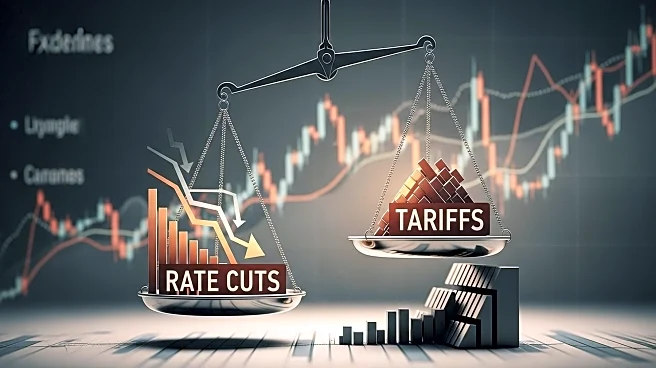What is the story about?
What's Happening?
The Federal Reserve has reduced interest rates for the first time this year, responding to signs of struggle in the labor market. This decision comes as the central bank aims to support economic growth amidst elevated inflation levels. The Fed is anticipated to implement another quarter-percentage point rate reduction at its upcoming meeting in October, with a potential additional cut in December. These monetary easing measures have contributed to a rally in the stock market, with the S&P 500 achieving 25 record closing highs over the past three months. However, investors remain cautious, as a strong employment report could prompt the Fed to slow its rate cut pace. Fed Chair Jerome Powell has highlighted the ongoing inflation risks, describing the situation as challenging.
Why It's Important?
The Federal Reserve's decision to cut interest rates is significant for several reasons. It reflects the central bank's efforts to stimulate the economy and address labor market challenges. The rate cuts are intended to make borrowing cheaper, potentially boosting consumer spending and business investment. However, the elevated inflation levels pose a risk, as they could limit the effectiveness of these measures. The stock market's response to the rate cuts indicates investor optimism, yet the high valuations of stocks suggest vulnerability to economic shocks. The upcoming jobs data will be crucial in determining the Fed's future actions, as it will provide insights into the labor market's health and potential recession risks.
What's Next?
The Federal Reserve is expected to continue monitoring economic indicators closely, particularly the labor market data, to guide its monetary policy decisions. The next rate cut decision will likely depend on the upcoming employment report, which could influence the pace of future cuts. Additionally, the looming deadline for congressional agreement to fund the government and avoid a shutdown adds uncertainty to the economic outlook. Investors will be watching these developments closely, as they could impact market stability and the broader economic environment.
Beyond the Headlines
The Federal Reserve's actions highlight the delicate balance between stimulating economic growth and managing inflation. The rate cuts aim to support the labor market, but they also underscore the challenges of navigating economic policy amidst global uncertainties. The potential government shutdown and its impact on the release of jobs data further complicate the situation, emphasizing the interconnectedness of fiscal and monetary policies. Long-term implications may include shifts in investor confidence and adjustments in corporate strategies as businesses adapt to changing economic conditions.
AI Generated Content
Do you find this article useful?















